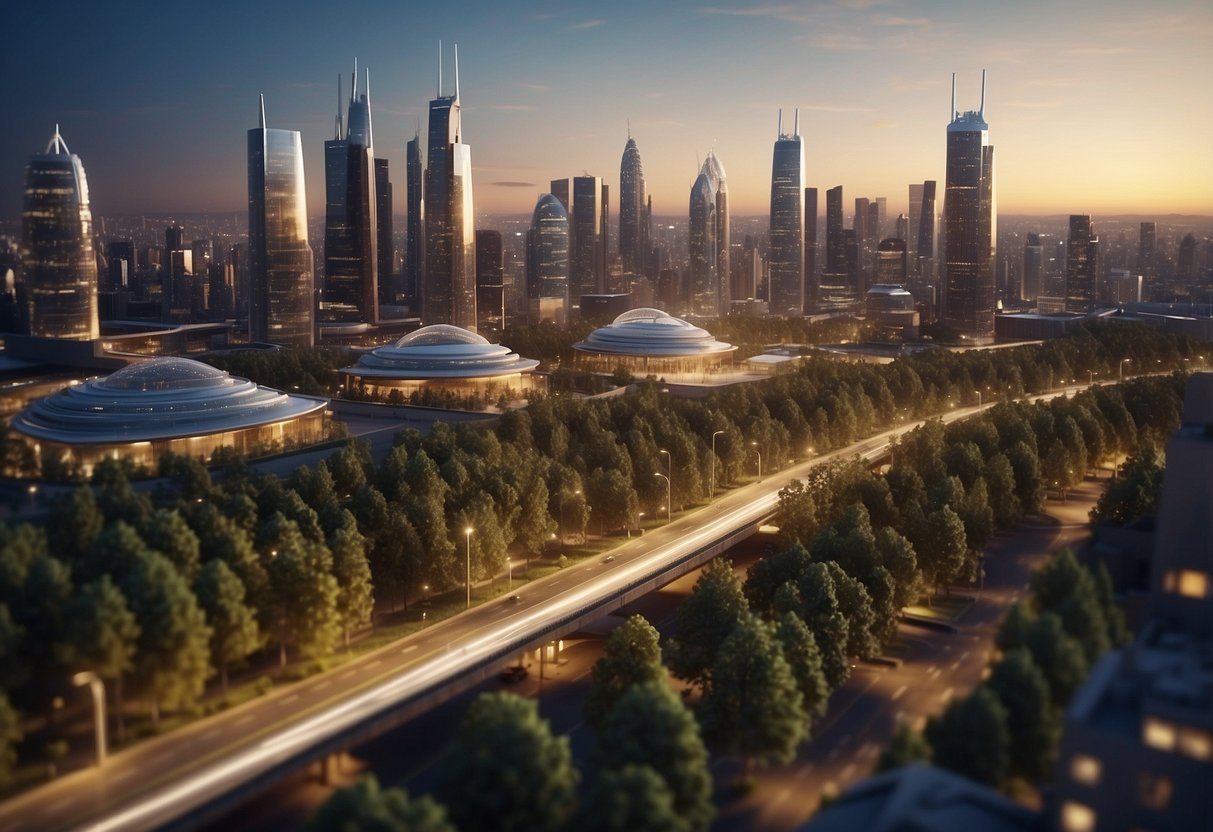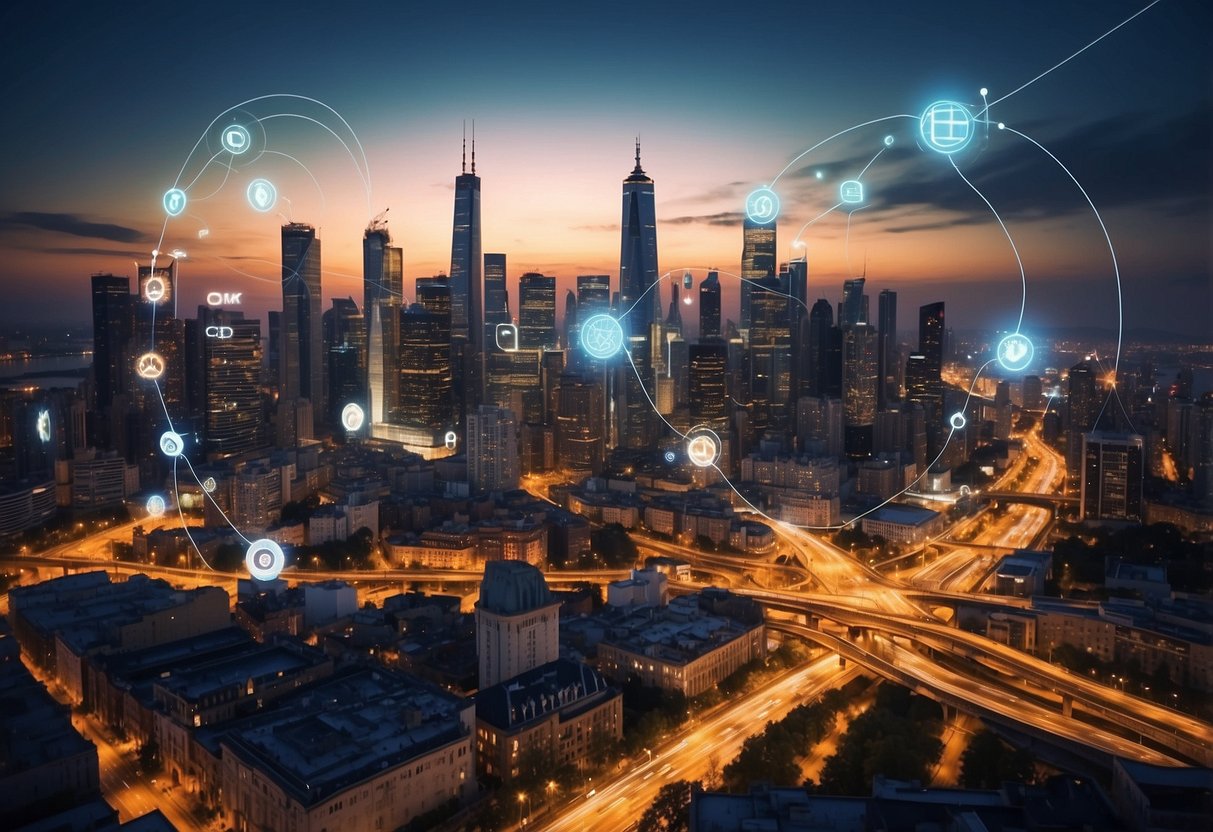Anúncios
5G technology is transforming how people connect and interact with the world around them. Its impact spans various sectors, including innovations in artificial intelligence (AI) and the Internet of Things (IoT), enhancing connectivity in ways previously unseen. As 5G networks roll out, they create a robust infrastructure that supports a vast number of devices, enabling smarter cities, efficient manufacturing, and improved healthcare systems.

The deployment of 5G is not just about faster internet speeds; it brings a wave of innovation. Industries are leveraging this technology to develop advanced applications that rely on real-time data and connectivity. This leads to more efficient processes and enhanced user experiences, pushing the boundaries of what is possible.
As 5G continues to expand, its potential is becoming increasingly clear. It allows for unprecedented opportunities, from connected vehicles to remote surgeries, showing how crucial this technology is for future advancements. The full spectrum of its impact is just beginning to unfold, inviting readers to explore what comes next.
The Evolution of Cellular Networks

Cellular networks have developed significantly over the years. This evolution has led to faster speeds and more reliable connections. Key factors include advancing technology and evolving standards for mobile communication.
From 4G to 5G: The Technological Leap
4G offered improved speed and internet access over its predecessors. It enabled users to stream videos and access social media more effectively. However, the arrival of 5G marks a major shift.
5G networks provide much higher speeds, with some estimates reaching up to 10 Gbps. This leap allows for smoother streaming, quicker downloads, and better support for numerous connected devices.
The transition from 4G to 5G also means lower latency. This is crucial for applications like online gaming and autonomous vehicles, where real-time communication is vital. As a result, 5G opens up new possibilities for industries such as healthcare and education.
Standards and Spectrum Allocation
The development of 5G technology was guided by the 3rd Generation Partnership Project (3GPP). This organization establishes the necessary standards for mobile communication.
Spectrum allocation is equally important for the success of 5G. Different frequency bands are used to transmit data, with 5G utilizing a broader spectrum than 4G. This includes millimeter waves, which were not available to previous generations.
Efficient spectrum use ensures that more devices can connect without latency issues. It also allows for better quality of service across different applications. This evolution continues to shape how people use mobile technology every day.
Core 5G Technologies and Infrastructure

5G technology introduces several key components that enhance mobile communication. These include advancements in radio access technologies, efficient bandwidth usage, and innovative network management approaches such as network slicing. Understanding these elements is crucial for grasping how 5G will transform connectivity.
Radio Access Technologies and Bandwidth
Radio access technologies (RAT) are essential to 5G networks. They include various methods of transmitting data over radio waves. 5G utilizes new technologies like Massive MIMO (Multiple Input Multiple Output), which allows multiple signals to be sent and received simultaneously.
This technology significantly increases capacity, enabling more users to connect at high speeds. The use of higher bandwidth frequencies, including millimeter waves, creates opportunities for faster data rates and lower latency. This enhanced bandwidth ensures that users experience swift and reliable connections.
Network Slicing and Its Importance
Network slicing is a key feature of 5G infrastructure. It enables the creation of multiple virtual networks on a single physical network. Each slice can be customized to meet specific user needs or applications.
For instance, a slice can be optimized for low-latency applications like remote surgery, while another can support high-bandwidth needs for video streaming. This flexibility enhances overall network efficiency and allows service providers to deliver tailored solutions to various sectors.
Cells, Bands, and Millimeter Waves
Cells in a 5G network are more numerous and smaller compared to earlier generations. This denser arrangement improves coverage and capacity, especially in urban areas. The use of millimeter-wave bands allows for higher data transmission rates but requires closer proximity to cells.
Each frequency band in 5G serves different purposes. Lower bands offer broader coverage, while higher bands support higher speeds. Integrating these various bands helps ensure a robust, efficient network capable of supporting the growing demand for mobile data.
Impact on Industries and Enterprises

5G technology is transforming various industries by enhancing operations and improving consumer experiences. Its high speed and low latency enable advancements in connected devices, digitization, and smart city initiatives.
Manufacturing and Industry 4.0
In manufacturing, 5G plays a vital role in the shift toward Industry 4.0. It supports real-time data sharing between machines, allowing for better coordination and efficiency. Factories equipped with 5G can utilize smart sensors to monitor equipment and predict maintenance needs. This predictive maintenance reduces downtime and costs.
Additionally, 5G enables the use of augmented reality in training and repair procedures. Technicians can access remote support instantly, leading to faster problem resolution. The ability to connect numerous devices simultaneously enhances automation and streamlines supply chain management.
Healthcare and Telemedicine Advancements
Healthcare is experiencing significant benefits from 5G technology. The ability to transmit large data files quickly improves telemedicine services, allowing doctors to perform remote consultations and monitor patients in real-time. High-definition video streams become seamless, enhancing the quality of care.
Connected devices, such as wearables, gather health data that medical professionals can analyze promptly. This data aids in early diagnosis and effective treatment plans. Moreover, 5G enables advanced applications, including robotic surgeries, where surgeons can operate on patients from miles away with precision and speed.
Retail Transformation and Consumer Experience
In retail, 5G enhances the consumer experience by enabling innovative shopping methods. Stores can deploy smart shelves that track inventory and provide real-time updates. This leads to improved stock management and customer satisfaction.
Additionally, augmented reality apps allow shoppers to visualize products in their homes before purchasing. 5G also supports more interactive features, such as personalized promotions based on real-time data. Retailers can leverage connected devices to create a more engaging shopping environment, driving sales and customer loyalty.
Enhanced Connectivity and User Experience

5G technology significantly improves connectivity and user experience across various platforms. Its high-speed internet and low latency are essential for new applications in augmented reality (AR), virtual reality (VR), cloud gaming, and the evolving capabilities of smartphones.
High-Speed Internet and Low Latency
5G offers internet speeds that can reach up to 10 Gbps, which is up to 100 times faster than 4G. This speed is crucial for users who rely on high-bandwidth applications.
With lower latency, often around 1 millisecond, the delay users experience when sending or receiving data is dramatically reduced. This is particularly important for real-time applications such as video calls or online gaming.
Devices connected to 5G networks can quickly exchange information, enhancing tasks that require instant responses. This level of performance allows for smoother browsing, quicker downloads, and more responsive applications.
Augmented Reality and Virtual Reality
5G enables richer experiences in AR and VR. With its high-speed connectivity, users can access detailed graphics and immersive environments. This technology allows educational and training systems to simulate real-world scenarios effectively.
For example, in fields like healthcare, VR can be used for training doctors through realistic simulations. AR applications for retail let customers try products virtually, making shopping more engaging.
The reduced latency also makes interactions in these spaces more fluid. Users can enjoy real-time feedback, making the experience much more natural and enjoyable.
Mobile and Cloud Gaming
5G transforms mobile gaming by offering seamless connectivity for cloud gaming platforms. With the high data transfer rates, users can play graphically demanding games on devices without the need for high-performance hardware.
This connectivity allows for features like multiplayer gaming without lag, which is vital for competitive gaming. Users can enjoy a console-like experience on their smartphones.
Major companies, like Apple and Google, are investing in cloud gaming services that utilize 5G to deliver high-quality games. This evolution not only enhances user experience but also opens up new revenue opportunities for developers.
Smartphones and Device Evolution
The rise of 5G has spurred advancements in smartphone technology. Devices now feature upgraded processors, enhanced graphics capabilities, and better battery life to handle demanding applications.
Smartphones are becoming central to daily activities, including working, gaming, and socializing. With 5G, users can expect faster app performance and improved video streaming.
Manufacturers are also incorporating AI into devices to optimize performance based on user behavior. This results in smarter interfaces and personalized experiences. As 5G continues to grow, more innovative features in smartphones will emerge, further enhancing user experience.
Deployment Challenges and Solutions

The rollout of 5G technology faces significant challenges that can impact its availability and effectiveness. Key issues include ensuring wide coverage and managing the costs associated with infrastructure development.
Availability and Coverage Issues
5G networks rely on three spectrum bands: low-band, mid-band, and high-band. Each has unique characteristics affecting availability and coverage.
- Low-Band: This band offers longer range and deeper penetration through buildings but delivers slower speeds. It is crucial for rural areas where coverage is less.
- Mid-Band: This balances speed and coverage, making it suitable for urban installations. However, it still struggles with range compared to low-band.
- High-Band: Known for extremely fast speeds, high-band has limited range and requires a dense network of small cells. Its availability is often restricted in many regions.
These factors can lead to gaps in service, particularly in rural areas or dense urban centers where demand is highest.
Infrastructure and Investment Costs
Building a robust 5G network demands significant investment in infrastructure. The costs involve deploying new antennas, small cells, and fiber optic lines.
- Investment Needs: Estimates suggest that hundreds of billions will be necessary for a comprehensive rollout.
- Technology Upgrades: Existing infrastructure must often be upgraded or replaced to support 5G. This added expense can be a barrier to entry for smaller providers.
- Regulatory Hurdles: Local regulations can slow down deployment. Obtaining permits for new installations often leads to delays.
Despite these challenges, strategic partnerships and government incentives can ease the financial burden, facilitating smoother deployment in key areas.
5G and the Internet of Things (IoT)

5G technology is significantly influencing the Internet of Things (IoT) landscape by enhancing connectivity and communication between devices. This section discusses how 5G supports the IoT ecosystem, powers smart grids and robotics, and enables advancements in automation and driverless cars.
Connecting the IoT Ecosystem
5G provides faster data transfer rates, allowing IoT devices to communicate more effectively. This speed is crucial for applications that require real-time data processing, such as health monitoring systems.
Additionally, 5G networks can handle a larger number of devices simultaneously. This is essential for urban areas packed with IoT sensors and smart devices. For instance, smart cities rely on interconnected systems to optimize traffic flow and energy use.
With improved bandwidth and reliability, 5G enhances the performance of connected devices, including wearables, home automation systems, and industrial IoT applications. These advancements lead to more efficient operations and increased productivity across various sectors.
Smart Grids and Robotics
Smart grids leverage 5G connectivity to improve energy management and distribution. These grids use IoT devices and sensors to collect data on energy use, making it easier to balance supply and demand.
Robotics also benefits from 5G by relying on real-time data for precise movements and decision-making. In manufacturing, robotic arms equipped with IoT sensors can operate more efficiently by making quick adjustments based on data feedback.
The combination of smart grids and automated robotics leads to reduced costs and increased sustainability in energy production and consumption. By integrating these technologies, cities can manage resources better and respond quickly to changes in demand.
Driverless Cars and Automation
5G plays a critical role in the development of driverless cars by enabling constant communication between vehicles and infrastructure. This connectivity allows for the sharing of data regarding traffic conditions, hazards, and navigation updates.
Automated systems in these vehicles rely on this data to make split-second decisions, enhancing safety and efficiency. With lower latency and increased reliability, 5G must be the backbone of future transportation networks.
Driverless cars equipped with advanced sensors and IoT capabilities can work together to optimize traffic flow and reduce congestion. This technology has the potential to transform urban mobility and redefine commuting experiences.
The Business and Economic Impact of 5G

5G technology is poised to transform how businesses operate and drive significant economic growth. It promises enhanced connectivity, improving both market growth and operational efficiency across various sectors.
Market Growth and CAGR
5G is expected to fuel substantial market growth worldwide. Analysts estimate that the global 5G market will reach approximately $667 billion by 2026, growing at a compound annual growth rate (CAGR) of around 68.1% from 2020 to 2026. Key players like Verizon, AT&T, Ericsson, Huawei, and Nokia are investing heavily to capture market share.
The technology will drive new revenue streams through advanced services. Industries such as healthcare, manufacturing, and automotive are set to adopt 5G at rapid rates, creating innovative applications that enhance service offerings and deliver enhanced customer experiences.
Strategic Operations and Efficiencies
5G enhances strategic operations by enabling real-time data transfer and communication. This capability allows companies to streamline processes and improve decision-making. Businesses leveraging 5G can achieve operational efficiencies, reducing downtime and significantly cutting costs.
For instance, T-Mobile and Verizon are incorporating 5G into their networks, allowing enterprises to adopt smarter logistics, better customer service, and more efficient inventory management. Enhanced mobility through 5G empowers employees to work more effectively, allowing remote collaboration and real-time updates across teams.
Supply Chains and GDP Contribution
The integration of 5G will transform supply chain dynamics and contribute to global GDP growth. Experts project that 5G will add approximately $1.3 trillion to global GDP by 2030. Enhanced connectivity will enable more precise tracking of goods and improved communication between suppliers and consumers.
Industries like logistics will benefit from quicker deliveries and reduced costs. Major companies are already assessing how 5G capabilities can optimize logistics and increase productivity. The deployment of 5G networks by businesses enhances labor efficiency, helping to drive economic development across various sectors.
Future Prospects and Upcoming Innovations

The future of 5G technology is promising due to the integration of artificial intelligence and machine learning, along with advancements in connectivity. These innovations will significantly impact various industries by enhancing efficiency and enabling the use of more devices seamlessly.
Artificial Intelligence and Machine Learning Integration
AI and ML will play crucial roles in the evolution of 5G technology. By analyzing data from devices connected to the network, AI can optimize resource allocation and network performance.
- Enhanced Decision Making: AI algorithms can predict network traffic and adjust the capabilities accordingly.
- Improved User Experience: Machine learning can personalize services offered based on user behavior, providing a tailored experience.
This integration helps support lower latency and better connectivity, making applications like real-time gaming and smart cities more viable.
The Next Wave of 5G Technology
The next wave of 5G will focus on supporting a greater number of devices with improved connectivity. New technology trends indicate an increase in connected devices, especially in the Internet of Things (IoT) sector.
- More Devices: By 2025, billions of devices will connect through 5G, facilitating smarter cities and homes.
- Strategic Innovations: Companies are developing 5G networks that will support advanced applications like autonomous vehicles and telemedicine.
These advancements promise to bring not only improved connectivity but also significant innovations that can transform daily life and various industries.